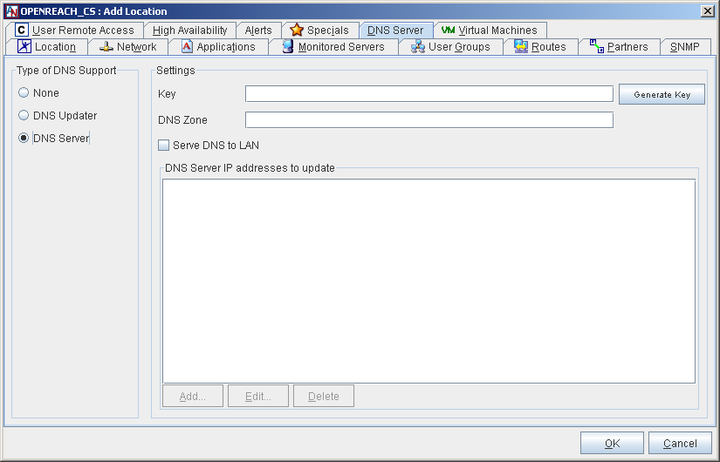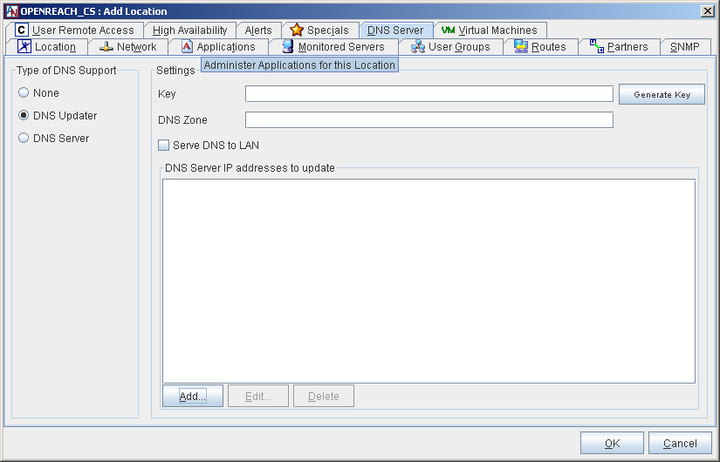Corente DNS services are designed to provide name resolution of applications across partner networks. Each Location may be placed in a separate DNS domain, or each site can be a subdomain of a central location’s DNS domain. When a partner is not in the same DNS domain or in a subdomain of the same domain, you can still share DNS records with that partner by selecting the Allow Partner Access to DNS Namespace option on the Partners tab.
You can use DNS to help organize the datacenter and make it easier to locate, manage, and access VMs and their applications. Corente DNS services tie DNS names to applications and are designed to provide name resolution of these applications across partner networks. Corente DNS is configured on the DNS Server tab of each CVSG-VE Location (and Location) in your domain.
A CVSG-VE Location may be configured as a DNS Server or as a DNS Updater:
If configured as a DNS Server, the CVSG-VE Location will answer DNS requests for applications that are configured locally, forward DNS requests to partner Locations for resolution, and forward all other DNS queries to the DNS servers configured on its Network tab.
If configured as a DNS Updater, the CVSG-VE Location will register the DNS names and addresses of the applications that you specify in third-party DNS servers. You must provide a list of the DNS servers that the Updater will be updating. These DNS servers must be configured to accept updates from the CVSG-VE Location and have the proper zone structure in place. These servers must also be reachable by the LAN interface of the CVSG-VE Location and be a member of its default User Group.
If configured as a DNS server, the CVE Location will answer queries for the applications registered in the DNS Zone it is assigned to serve. It will also answer reverse queries for the IP addresses corresponding to those applications.
On this screen, choose DNS Server and fill out the screen as follows:
Key: Updates to the DNS server must be sent and received securely, using the same key for all DNS servers and updaters that are used in your domain.
If you have already generated an HMAC-MD5 key for your domain, enter that key in the Key field.
If you have not yet generated an HMAC-MD5 key for your domain, generate a key using either the adjacent Generate Key button or your own key generator, and enter the key in the Key field. Copy this key and use it for all DNS servers and updaters in your domain.
DNS Zone: Enter a name for the zone for which this CVSG-VE Location’s DNS server will be responsible (for example, “zone.corente.com”, or an outlying zone, such as “here.zone.corente.com”, “there.zone.corente.com”, etc.).
Serve DNS to LAN: When this option is selected, any computer on the LAN that receives its addressing information via DHCP from the CVSG-VE Location (even those computers not participating in the Corente network) will be passed the LAN IP address of this CVSG-VE Location as its DNS server in the DHCP lease. The CVSG-VE Location will attempt to resolve any DNS query it receives. If it cannot answer a DNS query, the query will be forwarded to the other means that you have specified on the Network tab (i.e., a third-party primary or secondary DNS server whose IP address you supply, or a third-party DNS Server whose address is served dynamically to the CVSG-VE Location via DHCP).
If this option is not selected, then the DNS behavior for computers on the LAN receiving their addressing information via DHCP is determined by the settings on the Network tab.
You can also configure a CVSG-VE Location to be a DNS Updater. If configured as a DNS updater, the CVSG-VE Location will send DNS updates to a third-party DNS server concerning the applications registered on this CVSG-VE Location. It will not answer DNS queries itself.
The IP address of all DNS servers being updated by this DNS Updater must be included on the User Groups tab of this CVSG-VE Location and reachable by the CVSG-VE Location’s LAN (or WAN/LAN, if in the Peer configuration) IP address.
On this screen, choose DNS Updater and fill out the screen as follows:
Key: Updates to a DNS server should be sent securely, using the same key for all DNS servers and updaters that are used in your domain.
If you have already generated an HMAC-MD5 key for your domain, enter that key in the Key field.
If you have not yet generated an HMAC-MD5 key for your domain, generate a key using either the adjacent Generate Key button or your own key generator, and enter the key in the Key field. Copy this key and use it for all DNS servers and updaters in your domain.
DNS Zone: Enter the name of the zone about which this CVSG-VE Location will be updating the DNS server (for example, “zone.corente.com”, or an outlying zone, such as “here.zone.corente.com”, “there.zone.corente.com”, etc.).
Serve DNS to LAN: When this option is selected, any computer on the LAN that receives its addressing information via DHCP will be passed the IP addresses of the third-party DNS servers that are specified below in the DNS Server IP Addresses to update table as its DNS server(s) in the DHCP lease. These servers will be responsible for answering the DNS queries of those computers.
If this option is not selected, then the DNS behavior for computers on the LAN receiving their addressing information via DHCP is determined by the settings on the Network tab.
DNS Server IP Addresses to update: This table captures the IP addresses of DNS server(s) to which this CVSG-VE Location will be sending DNS updates. To add a new DNS server to this table, click Add and enter the DNS server’s IP address. You can Edit or Delete any entry in this table. Remember that any DNS server listed in this table must share the same secure key as this DNS Updater.
If you have configured your CVSG-VE Location as a DNS Server or DNS Updater, you should register any application that your CVSG-VE Location is distributing across the Corente network with Corente DNS.
To do this for an existing application, access the Applications tab and Edit an existing application. On the screen that is displayed, make sure the Register Application Name in DNS option is selected. After clicking OK twice on this page, then clicking OK on the next page and Saving your changes, the application name will registered in Corente DNS.
The DNS name of the application will be the DNS zone name of the application’s CVSG-VE Location prepended by the application name (for example, an application named “fileserver” in a zone named “here.corente.com” could be accessed by computers in partner Locations using the DNS name “fileserver.here.corente.com”).
If you would like a VM itself (and not just its applications) to be reachable via DNS name, you can register the VM as an application on this Applications tab and select the Register Application Name in DNS option for it.
On the Partner tab, you can elect to share the DNS records of this CVSG-VE Location with a remote partner, when this CVSG-VE Location is configured as a DNS Server or a DNS Updater and the partner is configured as a DNS Server or DNS Updater. Select the Allow Partner Access to DNS Namespace option to share the DNS records of this CVSG-VE Location with the partner. The partner will be allowed to perform lookups for the DNS names registered with this CVSG-VE Location even when the partner is not in the same DNS zone.
When the partner is configured as a DNS Updater:
If the Locations are in separate DNS domains, the DNS records must be manually forwarded from the DNS Updater to the DNS servers it is updating.
If one is in a subdomain of the other (e.g., this CVSG-VE Location is configured as a DNS Server and is in the subdomain of its partner, which is configured as a DNS Updater), Corente DNS will automatically forward the DNS records from the DNS Updater to the DNS servers it is updating.
If any NAT (Outbound or Inbound) is being performed for this partner, then the Perform DNS/WINs Fixup option must be selected on the Network tab of this CVSG-VE Location.
To access VMs from the datacenter, you can enable access to a VM via an RDP application. This option is selectable for each VM on a CVSG-VE, configurable on the Virtual Machines tab of the CVE Location form.
To connect to a VM via RDP, use the IP address of this CVE Location's Virtual Environment Host Interface and the port number that you specify for the Console Display Port for that specific VM.
For more information about the Console Display Port feature, refer to the Installation section of this document (Section 6.2, “Installation in App Net Manager”).



